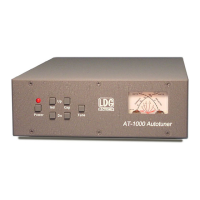Power too high
: if the power exceeds 125 watts, a tuning cycle will not begin, both meters bounce fast at
the High mark. They will continue to bounce until the RF is removed. In this case, reduce power and begin
a new tuning cycle.
SWR too high for the power level
: if power exceeds 100 Watts while the SWR is greater than 3, or if power
exceeds 75 watts while the SWR is greater than 5, a tuning cycle will not begin, and both meters will
bounce slowly to the High mark. They will continue to bounce until RF is removed. In this case, reduce
power and begin a new tuning cycle.
Loss of power during tune: if RF power is removed before a tuning cycle has ended, the FORWARD meter
will bounce once to the High mark. In this case, the tune is not stored; restore RF and begin a new tuning
cycle.
Final SWR over 3: in rare cases, your AT-1000 will not be able to achieve an SWR lower than 3. This is
most often due to attempting a tune very far from the resonant frequency of your antenna. The REVERSE
meter will bounce once to the High mark, and the resultant tune will not be stored in memory.
Successful tune
: When a tuning cycle ends with an SWR below 1.7, The REVERSE meter bounces once
then FORWARD meters bounce twice to the High mark, and the tuning results are stored in memory
1
. If
the tuning settings are the same as the last saved settings, the FORWARD meter will bounce only once, and
no additional memory will be used.
After tuning is completed, set your amplifier to operate, key your exciter and tune your amplifier as usual
(if needed). Good practice dictates tuning your amplifier into a 50-ohm dummy load with a suitable power
rating. You may tune your amplifier into the antenna through your AT-1000 providing it has tuned the
antenna to a low SWR, and also providing you do not exceed the specified ratings of either your amplifier
or your AT-1000. Never press the Tune button while transmitting more than 100 watts. Unkey when done;
you are ready to transmit.
Memory Operation
At the end of each successful tuning cycle (SWR < 1.7), the tuning parameters are stored in non-volatile
memory. There are 200 memory locations forming a stack of the 200 most recent successful tunes. Each
time a tuning cycle is started, the tuner very quickly tries these 200 stored values. If one of them gives an
SWR of 1.7 or less, the tuning cycle ends. If not, a full tuning cycle begins automatically, with the new
tuning parameters stored automatically upon successful completion of the cycle. Meter bounce codes
indicating a successful memory tune are the same as those for a manually executed tune cycle (see above).
The memory storage and tuning process is completely automatic, with no impact on your operation of the
tuner. The effect is much faster overall tuning once the tuner has "learned" your most common bands and
frequencies. You will probably want to use memory tuning most of the time.
A word about “roll-back” circuits
Modern amateur exciters with solid state finals usually employ a “rollback” circuit to protect the final
amplifier transistors from high SWR, which can damage or destroy them. A rollback circuit senses the
SWR at the antenna terminal during transmit, and reduces the output power as the SWR rises above a
preset level, often 2:1. The higher the SWR, the lower the power is set to prevent damage.
If your solid state or tube-type exciter has a rollback circuit, you can simply key down and tune as
described above at any power level from 20 to 100 watts. If your exciter lacks a rollback circuit, you must
manually set the power level for tuning to 20 watts. At higher power levels, the reflected power
encountered during the tuning cycle could damage your exciter. Check your exciter owner’s manual to
determine if yours has a rollback circuit.
8

